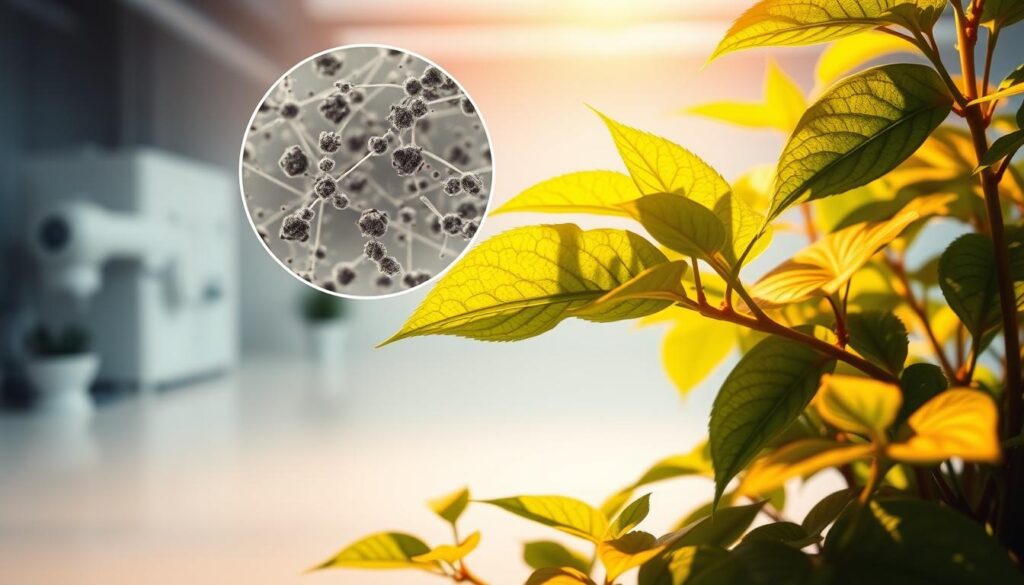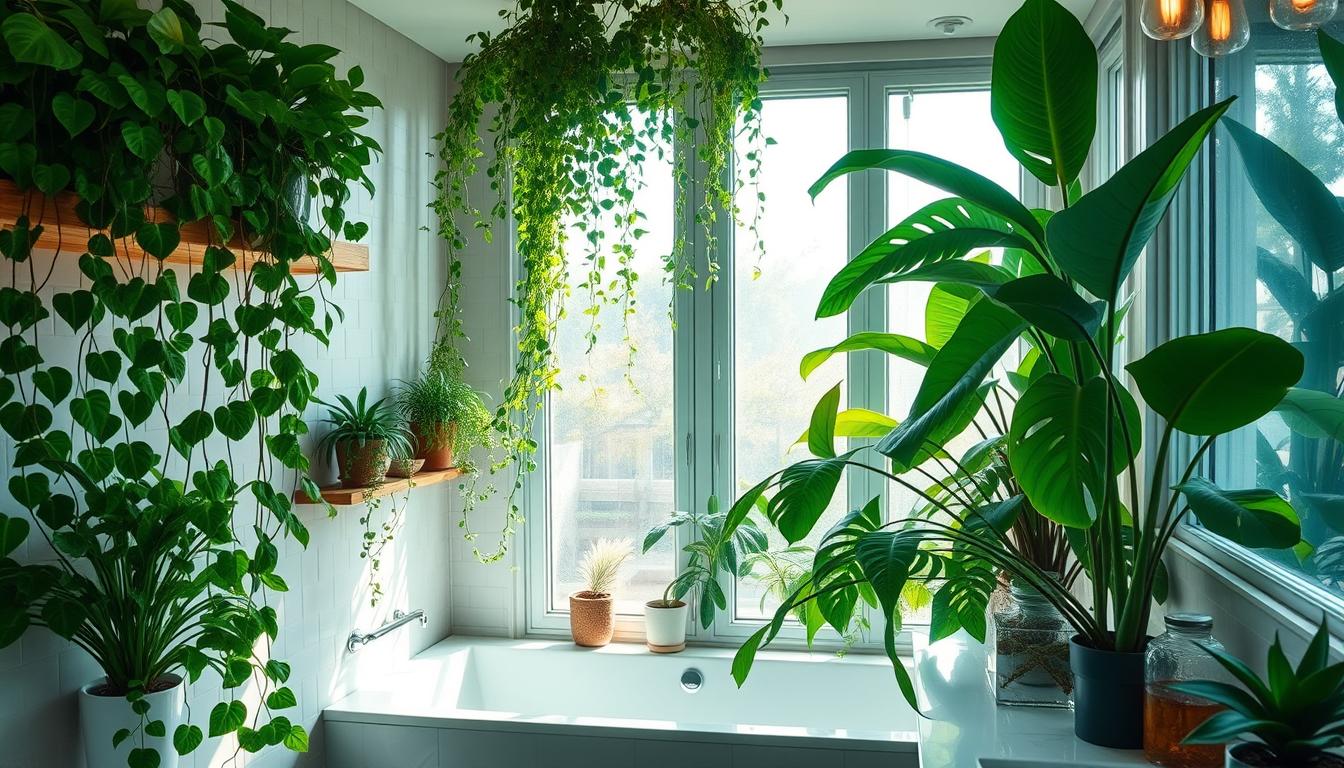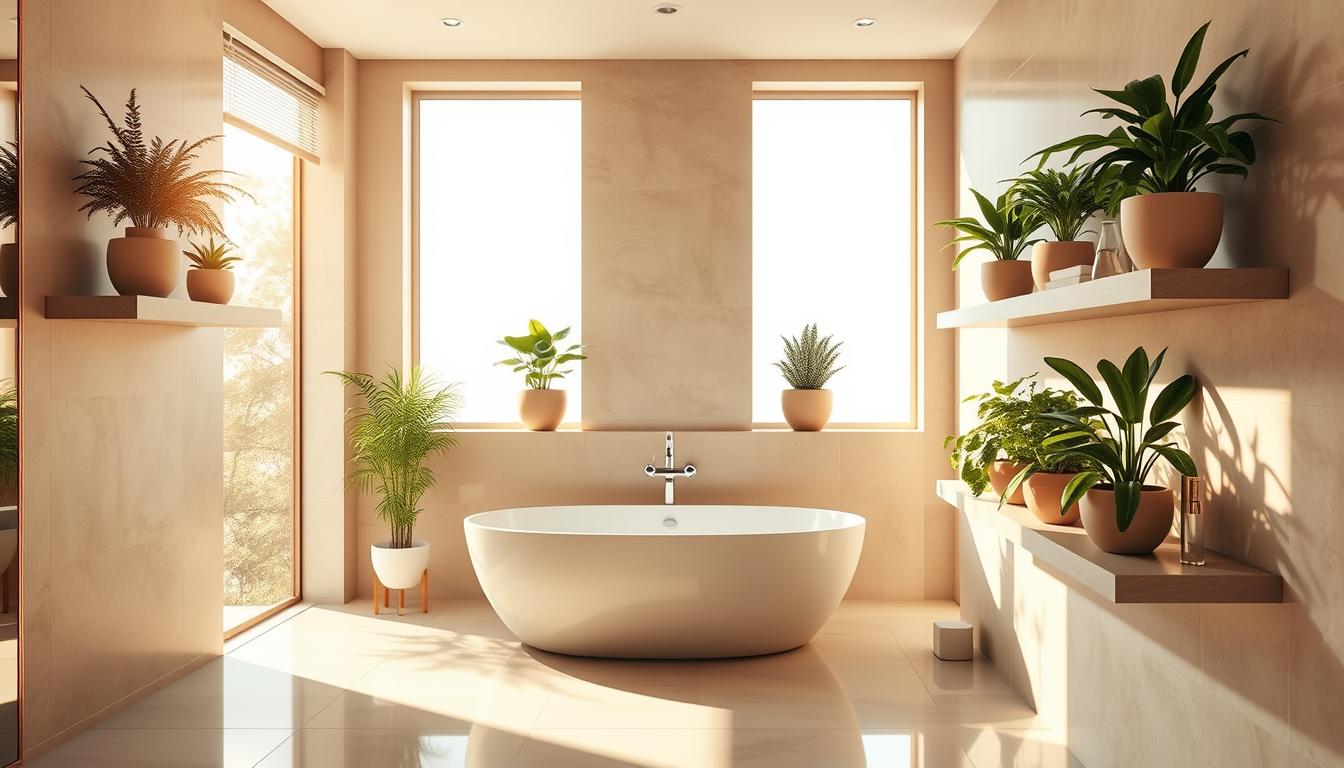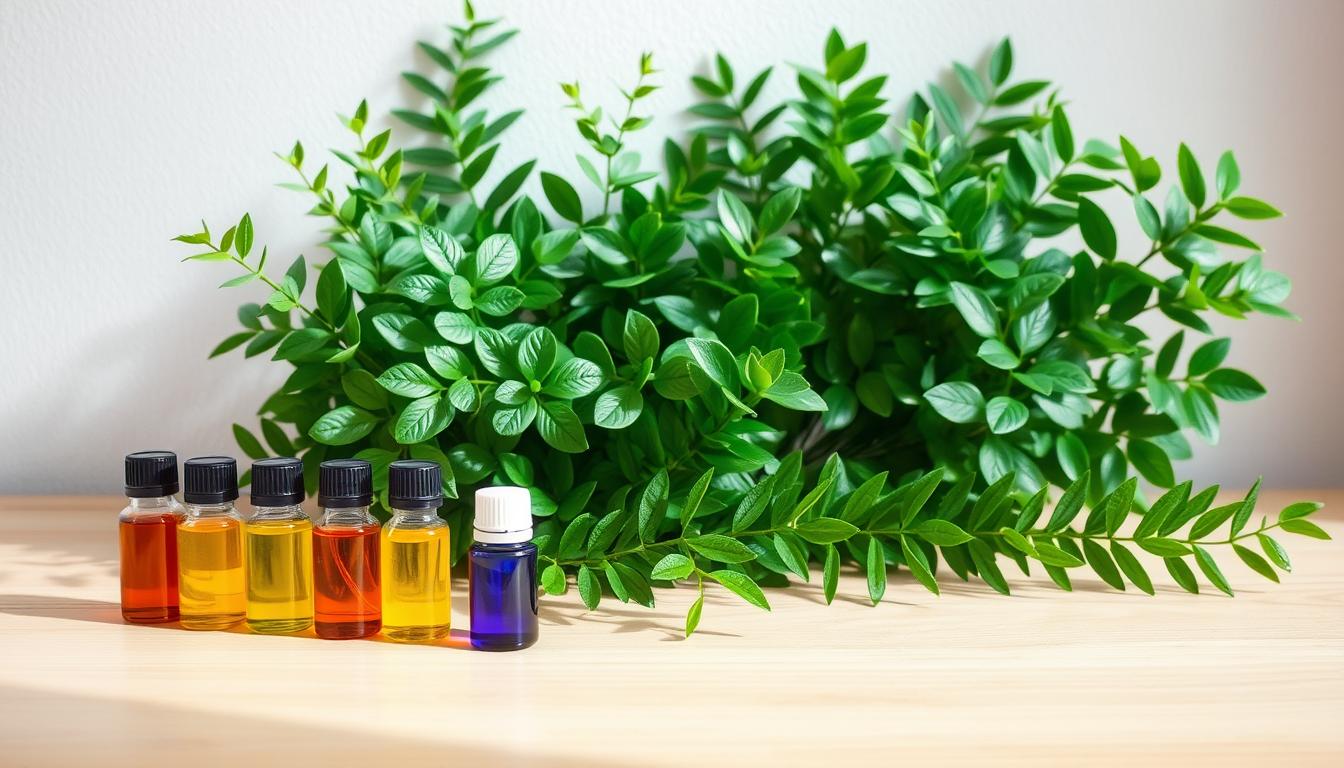UV light plays a key role in keeping indoor plants healthy. It’s especially useful for plants in damp areas like bathrooms. It fights off mold and keeps dust in check without using harsh chemicals. This natural method makes our indoor spaces look and feel better.
Introduction to UV Light and Plant Health
UV light is very important for plants to grow well. It helps plants make energy from sunlight better. This extra energy helps plants grow and fight off diseases. Adding UV light to your indoor garden helps your plants stay healthy.
Growing plants indoors can be tough due to less sunlight. But, with UV light, you can make indoor conditions similar to outdoors. This helps plants become stronger and fight diseases better. It makes your indoor garden a great place for plants to thrive.
Understanding Mold and Dust Issues on Plants
Keeping houseplants healthy means watching for troubles like mold and dust. Mold comes in many forms and can hurt our plants badly. Knowing how to care for your plants properly helps them stay vibrant and alive.
Common Types of Mold Affecting Plants
Mold is a big risk to plants. Learning about different types of mold helps us prevent them. Here are some common ones:
- Botrytis (gray mold) – shows as brown, dry leaves and stems
- Powdery Mildew – seen as a white, powdery coating on plants
These molds can cause serious diseases in plants if we don’t take care of them quickly.
Identifying Dust Accumulation on Plants
It’s important to check for dust on plants. Dust can block sunlight, harming photosynthesis and the plant’s health. You might see:
- Faded leaf color
- Slower growth
Cleaning leaves with a wet cloth helps keep plants healthy. This is a simple step in caring for your plants.
How UV Light Works Against Mold and Dust
UV light helps fight against mold and dust. It attacks mold spores’ DNA, stopping them from growing. This process doesn’t leave any harmful leftovers.
Using UV light early on can really make a difference. It prevents mold from spreading and helps keep dust away. This keeps plants healthy and thriving.
For indoor plant lovers, UV light is a must-have. It guards against mold and keeps your plant area dust-free. This technology ensures your plants grow well in a clean environment.
The Role of UV Light in Preventing Mold and Dust on Bathroom Fake Plants
Using UV light with bathroom plants has many benefits. One key benefit is improving indoor air quality. It does this by keeping mold and dust off artificial plants. This makes the living space healthier. Besides cleaner air, this light also keeps bathroom fake plants looking good.
Advantages of Using UV Light in Indoor Environments
UV light helps take care of bathroom plants in several ways. UV light advantages include:
- Stopping mold growth on artificial leaves, so they stay clean.
- Reducing dust, which makes air quality better and surfaces cleaner.
- Less allergens in the bathroom, which means better health and comfort.
- Keeping fake plants from getting damaged by the environment, so they last longer.
Impact on Aesthetics and Health
Using UV light makes bathroom fake plants look better. Clean, fresh-looking greenery improves the bathroom’s look and feel. With less bacteria and dust, the indoor air gets better. This makes the space more pleasant.
Different Types of UV Light and Their Applications
There are different types of UV light that help keep plants healthy. They are key in stopping mold and dust. Each kind—UVA, UVB, and UVC—works in its own way because of how their wavelengths act. This affects how they’re used in growing plants.
UVA, UVB, and UVC Explained
UVA, UVB, and UVC are parts of the ultraviolet spectrum, divided by how long their waves are. Here are the primary types:
- UVA: This type goes deeper into plant parts and helps with making food in the plant because it has the longest wavelength, from 320 to 400 nanometers.
- UVB: Its waves are between 280 and 320 nanometers. UVB stops mold from growing. It makes plants create shields against germs.
- UVC: UVC has really short wavelengths, from 100 to 280 nanometers. It kills a lot of tiny germs, including fungi, bacteria, and viruses, which makes it great for cleaning.
How Different Wavelengths Affect Fungal Growth
UVB and UVC light change how fungi grow and affect plant health. UVB makes plants more resistant to mold by stressing them slightly. However, UVC light breaks apart the cells of fungi and other bad microorganisms. Using these UV lights helps plants become stronger and less likely to get moldy.
Integrating UV Light in Grow Systems
Adding UV light to plant care systems boosts the health and growth of indoor plants. UV fixtures help prevent mold and dust. They also improve plant growth if placed correctly. Knowing the different UV fixtures and where to put them is key for healthier plants.
Types of UV Light Fixtures for Plant Care
There are several UV fixtures made for plants:
- Fluorescent UV fixtures: These are affordable and perfect for small gardens.
- LED UV fixtures: They save energy and have different wavelengths to help plants.
- High-intensity discharge (HID) UV fixtures: Great for large areas because they’re very bright.
Optimal Placement for Maximum Effectiveness
To get the most from UV lights, placement is important. Here are some tips:
- Hang lights above plants to spread light evenly and boost photosynthesis.
- Keep lights 12 to 24 inches away to avoid damaging leaves.
- Move lights based on how big plants are. Bring them closer when plants are small and keep them further as they grow.
Preventive Measures Against Mold and Dust
Keeping plants in a clean, healthy setting is more than using UV light. It includes monitoring air quality and controlling humidity. These steps help prevent mold and stop dust from gathering. Also, watering plants the right way boosts their health.
Importance of Air Quality and Humidity Control
Good air quality keeps plants strong. If the air doesn’t move, humidity can rise. This makes a perfect place for mold. Moving air helps manage humidity and keeps dust off plants. Using dehumidifiers or fans helps keep the air just right.
Watering Techniques to Minimize Fungal Growth
How you water plants can stop mold from growing. Watering in the morning gives plants time to drink up during the day. This reduces water left overnight that mold loves. Make sure pots let out extra water to avoid fungal problems.
Practical Applications of UV Light in Home Gardening
UV light has many benefits for home gardening. It can make plants healthier and reduce mold and dust. Gardeners can use UV light in different ways to make indoor plants thrive.
One easy method is to use special grow lights with UV light. These lights help plants grow faster and fight off fungi. Putting the lights in the right spot gives all plants the light they need. This stops mold from growing on the soil and plants.
Using a light schedule is also a good idea. It gives plants the light they need without wearing them out. Timers can make this easy, so gardeners can do other things.
Keeping the air right is key. Watching the humidity and air flow helps the UV light work better to stop mold and dust. Adding UV light to your plant care makes everything look and grow better.
Using these UV light tips can make home gardening more rewarding. It helps with mold and dust problems too.
Benefits of Regular UV Light Exposure
Getting UV light regularly helps plants a lot, especially in fighting off fungus. Studies show that UV light can significantly cut down fungus spores. This leads to plants growing healthier and stronger.
Reduction of Fungal Spores
Using UV light for plants offers great perks:
- Inhibition of mold growth, thereby improving overall plant health.
- Encouragement of stronger plants that are less susceptible to diseases.
- Decrease in reliance on chemical fungicides, fostering an eco-friendly approach to plant care.
Studies back up the frequent use of UV light, showing its effectiveness. It creates a bad spot for fungal spores to thrive. This results in less mold and healthier plants in gardens.

Challenges and Limitations of UV Light Use
Using UV light for plant care comes with its own set of challenges. It can fight mold and dust well. But, some factors could harm your plants. Knowing these risks is key for its right use.
Potential Risks for Plant Health
Too much UV light can harm plants in several ways:
- Leaf burn happens with too much UV radiation.
- Plants can stop growing well if their tissues get damaged.
- Weak plants might get more bugs and diseases.
It’s vital to know about these UV light problems. This knowledge helps prevent harm and keeps plants healthy.
Best Practices for Safe Usage
There are ways to use UV light without risking plant health:
- Adjust the UV light time based on the plant and light strength.
- Use filters to block bad wavelengths.
- Keep an eye on temperature to prevent heat stress.
Following these steps lets you enjoy UV light benefits safely. Your plants can stay healthy and thrive.
Conclusion
Using UV light technology helps plants stay healthy, especially in keeping mold away in indoor places like bathrooms. We’ve seen how UV light is great at cutting down dust and mold, which makes plants healthier.
Putting plants under UV light keeps them bright. It also helps make the air in your room cleaner and nicer to live in. Using UV light for plants is a smart move to prevent mold and keep your greenery in top shape.
The more we learn about UV light, the more useful it becomes for gardening lovers. With UV light, you can greatly cut down on mold problems. This lets your indoor garden flourish beautifully.



